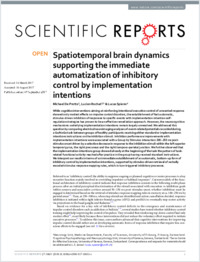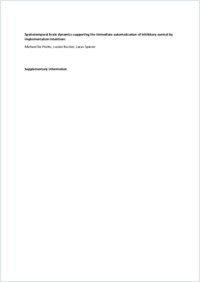Spatiotemporal brain dynamics supporting the immediate automatization of inhibitory control by implementation intentions
- De Pretto, Michael Neurology Unit, Medicine Department, University of Fribourg, Switzerland.
- Rochat, Lucien Cognitive Psychopathology and Neuropsychology Unit, University of Geneva, Switzerland - Swiss Centre for Affective Sciences, University of Geneva, Switzerland
- Spierer, Lucas Neurology Unit, Medicine Department, University of Fribourg, Switzerland.
-
07.09.2017
Published in:
- Scientific Reports. - 2017, vol. 7, no. 1, p. 10821
English
While cognitive interventions aiming at reinforcing intentional executive control of unwanted response showed only modest effects on impulse control disorders, the establishment of fast automatic, stimulus-driven inhibition of responses to specific events with implementation intention self-regulation strategies has proven to be an effective remediation approach. However, the neurocognitive mechanisms underlying implementation intentions remain largely unresolved. We addressed this question by comparing electrical neuroimaging analyses of event-related potentials recorded during a Go/NoGo task between groups of healthy participants receiving either standard or implementation intentions instructions on the inhibition stimuli. Inhibition performance improvements with implementation intentions were associated with a Group by Stimulus interaction 200–250 ms post-stimulus onset driven by a selective decrease in response to the inhibition stimuli within the left superior temporal gyrus, the right precuneus and the right temporo-parietal junction. We further observed that the implementation intentions group showed already at the beginning of the task the pattern of task-related functional activity reached after practice in the group having received standard instructions. We interpret our results in terms of an immediate establishment of an automatic, bottom-up form of inhibitory control by implementation intentions, supported by stimulus-driven retrieval of verbally encoded stimulus- response mapping rules, which in turn triggered inhibitory processes.
- Faculty
- Faculté des sciences et de médecine
- Department
- Médecine 3ème année
- Language
-
- English
- Classification
- Biological sciences
- License
-
License undefined
- Identifiers
-
- RERO DOC 305758
- DOI 10.1038/s41598-017-10832-x
- Persistent URL
- https://folia.unifr.ch/unifr/documents/305925
Other files
Statistics
Document views: 104
File downloads:
- pdf: 202
- Supplementary material: 104

